Technology
Wooing Staff Back To Work: Smart Office Buildings May Bring An Unexpected Bonus
Anand Parthasarathy
Sep 30, 2022, 04:02 PM | Updated 04:05 PM IST
Save & read from anywhere!
Bookmark stories for easy access on any device or the Swarajya app.
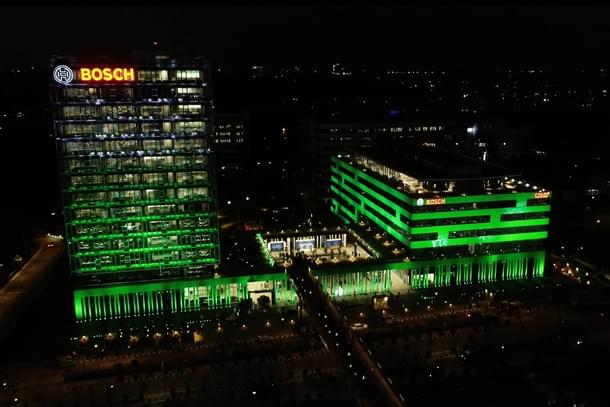
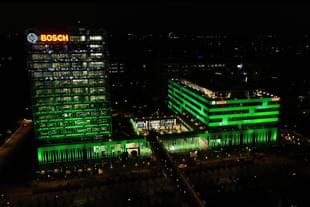
Imagine you are a tech professional and have been working from home for the last two years and more.
Your employer invites you to return to work, but you are not very keen to restart that twice-daily commute at rush hour.
Then you are informed about some changes that have been made in your workplace during the 20 months or so when it was almost empty, allowing management to put in some innovations:
— There is a new cloud-based smart-parking solution you can access on your mobile phone: if you plan on going to work on a particular day, you can check if there is a vacant parking spot available inside the campus.
If yes, you can book it. If the parking bays are full you are encouraged to come on another day.
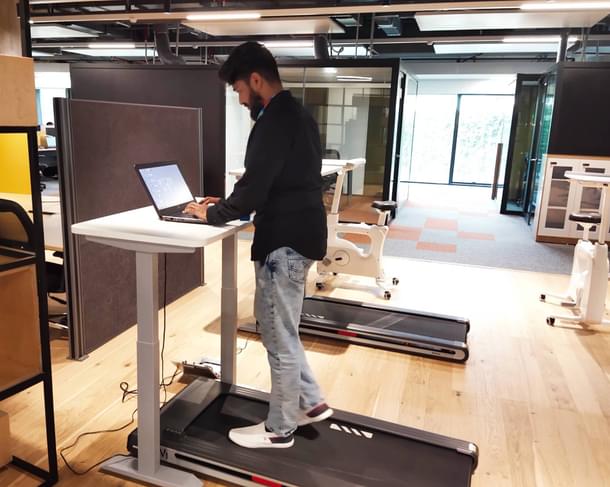
— Next, you check to see if a workspace would be free for the six hours or so you expect to be working.
Your employer now provides workspaces for just 70 per cent of the staff at any given time.
You can see a real time map of the Agile Workspace — with 3,200 seats bookable. Like booking seats in a multiplex, you can select the exact seat of your choice — away from the exit, close to a window or whatever works for you.
If you want to save a trip to your gym, you can even choose to work at one of a dozen ‘cardio’ treadmills or exercise cycling machines with fixtures to strap on your laptop: work as you workout!
— Once you have reached your office and used your phone to locate your parking spot, you park your car or bike and if your selected seat is some distance away, you hitch a ride in the electric buggy that is constantly shuttling around the campus.
— Having reached your seat (grabbing a cup of complementary coffee en route from the conveniently-placed dispenser), you then proceed to adjust the temperature to your exact liking.
Yes, the hall which seats some 500 others like you, is centrally air-conditioned, but clever engineers in your plant have added a network of water pipes to the gas-cooling system.
This allows you to adjust the temperature right above you to your taste. Goodbye to the days when some always found the temperature in a workspace too cold while others found it too warm — but had to lump it.
— Final adjustment: the ambient lighting in the hall is fixed at 100 lux. But if your work demands better illumination, you have individual controls that allow you to turn on a desk lamp and adjust it up to 250 lux.
All set, let’s get to work then. And who wouldn’t? It makes the switch back to office something to look forward to because, the changes since you were here last (2020), mean one thing: you’re in control now.
The scenario described here is real. It’s all happening exactly as detailed, at the new 3,300 square metre campus called Spark.NXT created at the Adugodi, Bengaluru campus of Robert Bosch, the Germany-headquartered global automotive, power tools and braking system specialists.
It was inaugurated by Prime Minister Narendra Modi on 30 June this year to mark 100 years of Bosch operations and manufacturing in India.
In his video-taped message, he said he was confident that “this campus will take the lead in developing futuristic solutions for India – and the world …It was (already) an example of German engineering and Indian energy.”
Three months is a fair period for a new system to complete its proving phase — which is why, just shy of 90 days after it was opened, this correspondent was allowed to check out for Swarajya’s readers multiple smart solutions.
For instance, smart parking, agile work spaces and air quality monitoring and control to visitor management and security/surveillance which go to make Spark.NXT, one of the smartest office spaces in India today — and one where 85 per cent of its campus is powered by green, renewable energy.
In just three months, I learned, an 8 per cent reduction in energy consumption has been achieved.
Even before the twin towers of the new office blocks were opened Bosch, in India — as indeed all its 400 locations worldwide — has been carbon neutral.
Sustainability goes hand in hand with security and safety: which is why Bosch engineers who designed inhouse, all the smart solutions described above, also put in place a system which wipes away the waiting time of visitors who may need to visit the facility.
Face Recognition, GPS-Enabled Visitor Badge
Once my visit was approved, I received a text message with a link that encouraged me to upload the usual ID and contact details and mail it along with a fresh selfie.
This generated a QR code, which allowed me on arrival at Spark.NXT, to jump the queue of casual visitors, look into the camera of a self-operated kiosk which then did facial recognition, matched it with my pre sent selfie and created a smart card on a lanyard that ensured I could visit all the areas that were part of my tour — and nowhere else.
The smart card was GPS-driven and at any point, on my smartphone, a map guided me step by step to my next planned location. (I’m guessing it allowed the system to track me at all times and nudge me gently if I strayed into a no-go area).
All employees — at Bosch they are called “associates” — also use a similar phone and smart badge-based system.
In addition to the more tangible benefits of a sharply-reduced energy bill, investment in such smart technologies today, is seeing some unexpected bonuses: Like most large tech-driven enterprises, Bosch is slowly moving away from the work from home regime of the Covid lockdowns and is encouraging its associates to return to their desks, albeit without coercive pressures.
Incredibly — and I imagine in no small measure because of the new staff-friendly features — some 70 per cent of the workforce at the Robert Bosch facility I visited have chosen to come in, three-four days a week. A smart move — literally — for all concerned.
National Energy Leader: Bearys
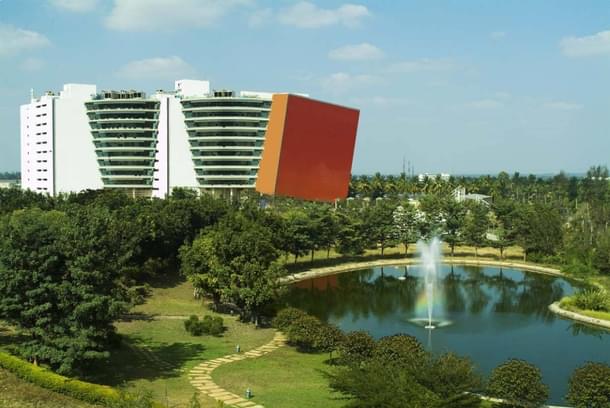
Bosch is by no means the only enterprise in India that has found that smart makes sense — in buildings and in logistics and infrastructure.
Many leading infotech and tech real estate companies have made the push to smart office buildings.
Last week, the Mangaluru-based Bearys Group won the ‘National Award for Excellence in Energy Management’ instituted by the Confederation of Indian Industry for the third consecutive year, and was also declared the ‘National Energy Leader,’ for its Bearys Global Research Triangle complex (BGRT), in Whitefield, Bengaluru.
BGRT claims the distinction of being India’s R&D Park accorded the LEED (Leadership in Energy and Environmental Design) platinum certification.
It is a 21-acre research enclave, modelled on the celebrated Research Triangle Park (RTP), in North Carolina, US.
A River Runs Through IT
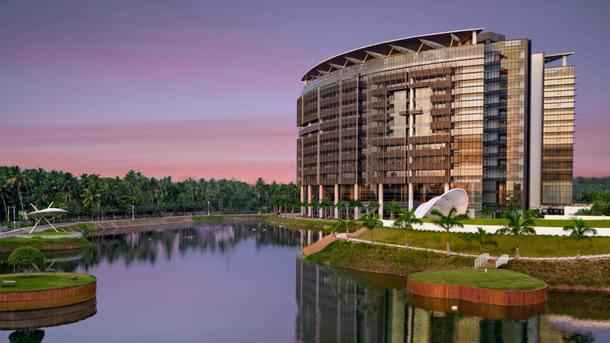
Over a decade ago, many tech players turned to Cisco India for its Smart Connected Real Estate Solutions which converged building, safety and communication networks into a single Open Internet Protocol or IP standard, in effect, offering a single platform for both building management and the IT systems within.
One of the first beneficiaries in India was the California, London and India- based, Indian talent-led IT services and solutions company, UST Global (formerly US Technologies): which ploughed Cisco expertise into its new campus in Thiruvananthapuram, Kerala.
The 36-acre closed to the Technopark, includes a private 12-acre water body that runs through the 6,500 sq-m campus.
Inaugurated in 2016, the UST campus was state-of-art at the time it was constructed and still a striking feature of the skyline on the NH by-pass.
It launched a trend of open, cubicle-less workspaces, with people working anywhere, even on the roof, if they cared for spectacular views.
It can seat around 8,000 and boasts many air-conditioning, load-reducing daylight harvesting features.

Cisco was also responsible for some of the smart features in Larsen & Toubro’s green corporate office tower, the A M Naik Tower in Powai, Mumbai opened in December 2020. Some 5,000 employees work here in this 15-storey, 1.03 lakh sq-m facility.
Many of the touchless features from parking to lighting and air temperature, are similar in concept to the Bosch facility in Bengaluru.
In April, Swarajya reported on a post-pandemic surge in multinational companies setting up large India operations.
From ABB in Bengaluru to Trimble in Chennai to IBM in Kochi (and that is just in South India), all these new facilities involved green and smart infrastructure to varying degrees.
It is a no brainer — even as they are calling 2022, the first year of slow recovery from the pandemic, the Year of the Smart Building.
From Cyberabad in Hyderabad to the IT high rises in Gurugram and Noida in the National Capital region to the Baner area of Pune, going ‘green’ is the ‘smart’, way to go (pun intended).
L&T’s Group CIO Vinay Khargaonkar, underlined the new message ‘blowin’ in the wind’ as it wafts over yet another high-tech high rise:
“In 2020, we all learnt a lesson: Buildings cannot be the same anymore. As organizations are struggling to determine how to return their workforce safely back to office, guests back to hotels, shoppers back to the malls, we know that technology is the answer to all of this.”
Anand Parthasarathy is managing director at Online India Tech Pvt Ltd and a veteran IT journalist who has written about the Indian technology landscape for more than 15 years for The Hindu.




